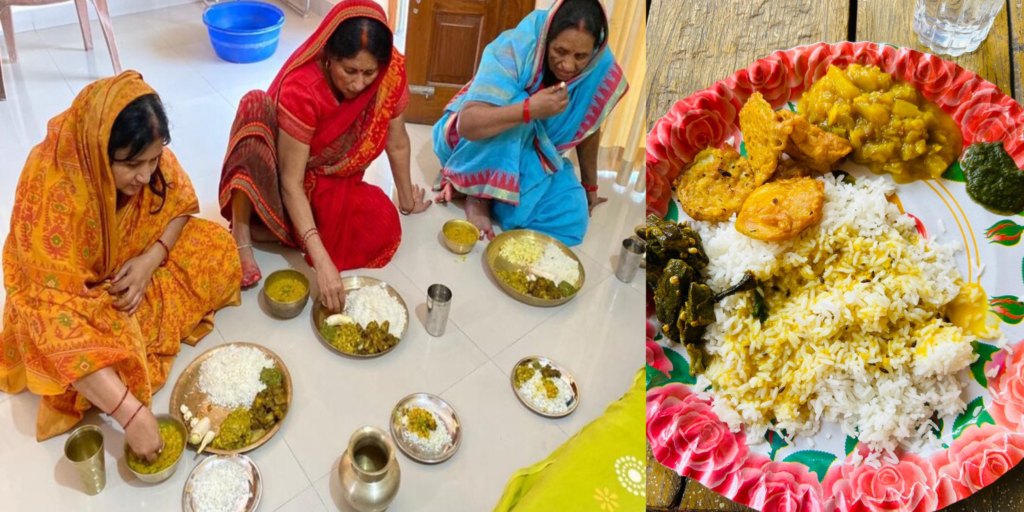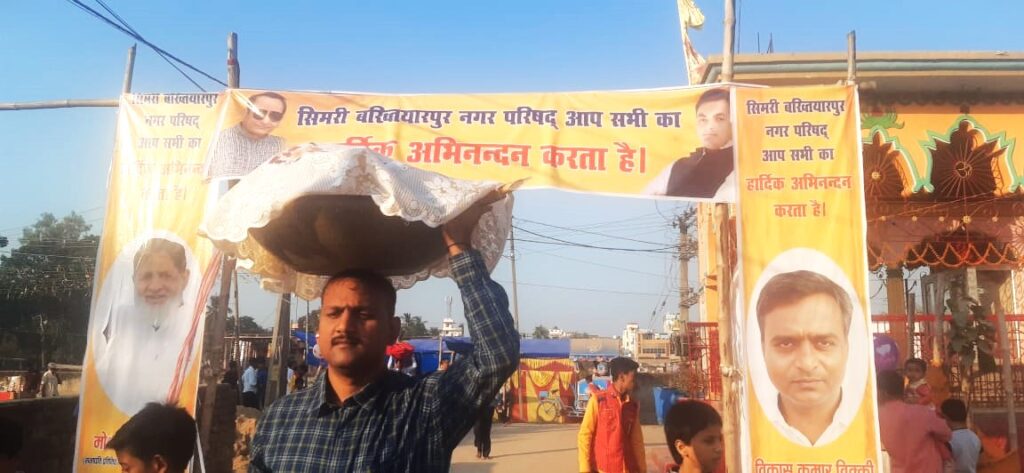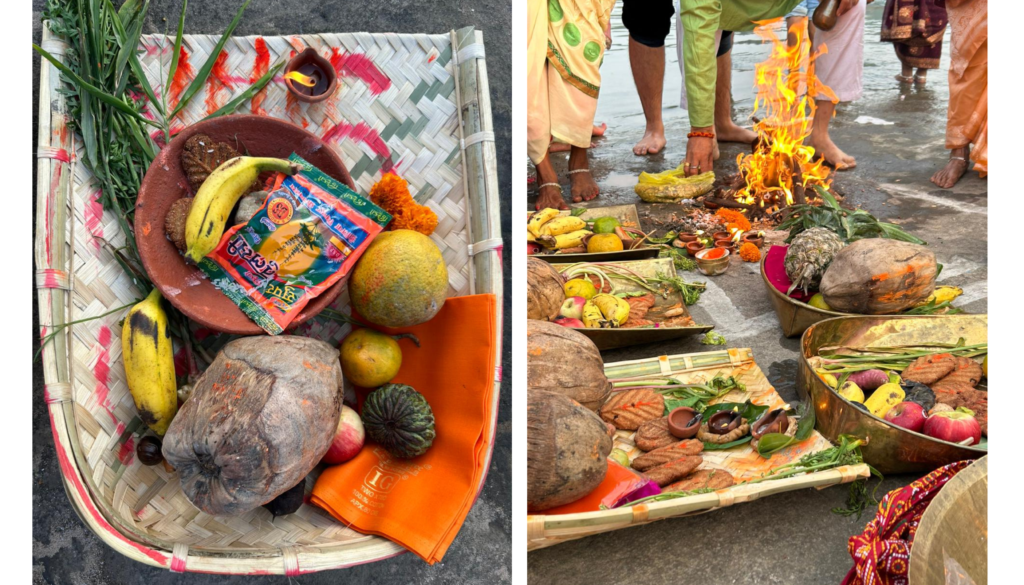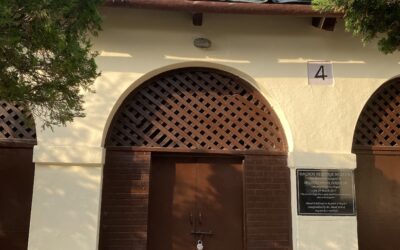What is Chhath Puja?
Chhath Puja is an yearly four daylong celebration. It is celebrated in the Bihar, UP and Jharkhand. Over the years the prevelance and celebration of Chhath Puja has increased around the world due to Bihari migration across the world. It is celebrated to honour the Sun, as it is believed that it is only because of the sun that we are able to live our lives. All the aspects of our lives, weather, water, food, shelter is all dependent on Sun so it is a celebration to thanks the Surye Devta ( Lord Sun) on Chhath Puja.
The married women of the house observe fast for 4 days during Chhath Puja.This year, I have the privilege of being in Bihar to experience the vibrant festivities. Being a fellow in Bihar has deepened my understanding of the festival and its significance. Let’s explore the day-wise rituals of Chhath Puja.
Day 1 : Nahaaye Khaaye (Bath and Eat)

Right: Kaddu Bhaat
Nahaaye Khaaye marks the start of the Chhath Festivities. It is the first day of Chhath Puja which translates to “bathing and eating”. People mostly spend the day at home and ensure that the house is completely clean. The females of the house take charge of preparing a traditional Chhath meal known as Kaddu-Bhaat. This meal includes a preparation of chickpeas and bottle gourd.
This meal has to be strictly vegetarian and all the female devotees or anyone who keeps the fast can consume the meal only after taking full body bath (getting pure) in the morning. The fast starts after eating Kaddu Bhat and finishes the next day with the meal of Kharna Puja. During the fasting period the devotees abstain from even consuming water. This marks the 1st day of Chhath Puja.
Day 2: Kharna

Kharna is the day 2 of the Chhath Festivities. On this day, people give special attention to thoroughly cleaning the house. During the four days of Chhath rituals, one can’t eat non-vegeatrian food. To ensure that everything is ‘clean’ people even avoid cooking kharna prasad (blessed food) on an old stove, and only use new or designated utensils.
After fasting through the first day, the devotees eat rice kheer with jaggery after worshipping at night then again start a waterless fast of 36 hours. For making kheer and roti for the day it is important to clean the rice and wheat thoroughly as well as dry and grind the wheat at home only. After making the meal (prasad), the devotees (vratis) make the offering to the deities and consume the prasad to start their 36 hour fast.


Day 3: Sandhya Arghya (Evening offering to the Sun)
This is the main day of the Chhath Puja. Here in the block of Simri Baktiarpur, people have made necessary arrangements to make the ghats accessible to the devotees. On this day all the devotees gather on their respective ghats (allocated places on the pond area) to offer water to the sun also known as ‘Arghya Dena’ . The people start gathering at the pond from 3’0 clock onwards in the afternoon.
Everyone has to travel from their home to the ghat area on foot without slippers irrespective how far the ghat is from the home. The women prepare a prasad thali for each family member. The men of the family carry all the prasad thalis in a tokri on their head, barefoot till the ghat. The devotees lay all the thalis on the ghat and wait for the sunset.
At the sunset the female devotees step into the water, holding their gildan (bamboo basket) facing the sun and start the prayers. They dip into the water, rotating with the prasad basket and seeking blessing from Lord Sun and Chhatti Maiyya. They observe this fast to pray for the success, prosperity, and longevity of their husbands and kids. After offering water to the Sun, the baskets are initially brought back home and then returned to the ghat in the morning for the sunrise offering. Which will mark the end of Chhath Puja.


Bottom: One family setting their prasad thalis in a line to get ready for the sunset arghya

Right: Sandhya Arghya – women offering water to Surya Devta (Sun God)
Day 4 : Usha Arghya ( Morning offering to the Sun)
Usha Arghya is the final day of Chhath Puja marking the conclusion of four days of devotion and fasting. On this day devotees will offer the water to the rising sun. Therefore, the devotees wake up before sunrise and reach their respective ghats as early as 4 am in the morning. This day is similar to the previous day (Sandhya Arghya). When it’s dark the lights of the burning diyas make the scene absolutely mesmerizing. After the devotees perform the mornign rituals, they distribute the prasad in the thalis among the people. This symbolizes a sense of brotherhood and community belonging. Chhath Puja elevates the spiritual connection among the devotees, as it revolves around expressing gratitude to the Lord Sun for our existence.
The Prasad Thali

My Takeaways From The Experience
Chhath Puja is a way to thank the Sun God for constantly emitting his light and sustaining everyone. These traditions have been passed on from generations in the Bihari culture. People believe that by keeping the fast during Chhath Puja they can attain prosperity and good health for their family. Chhath Puja marks a sense of community for the Bihari Community. While everyone seems to enjoy the festivities the workload on women definitely increases. My favorite part of the festivities were the thekuas.
Have you witnessed Chhath Puja? Tell me some of your favourite things about various Indian festivals, in the comments below.




One of my favorite festivals is ONAM. One can witness people narrating the story of King Mahabalipuram, women dressed beautifully, brilliant food and interactions in the community. To watch the boat race is like the cherry on the cake. Oooo I long to visit kerala during Onam every year.